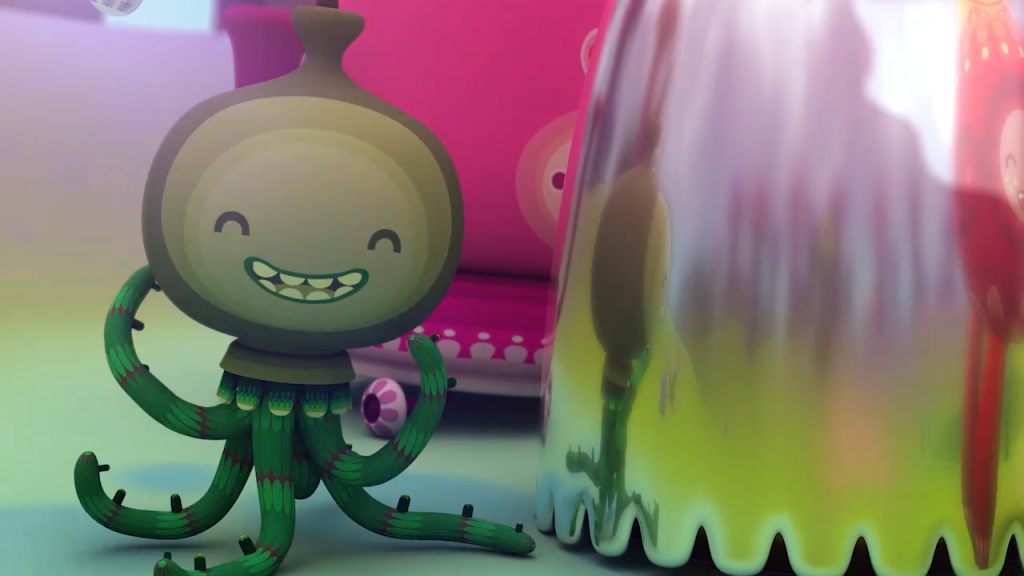
Mirror
Many adults would like to understand more about why buddi catches children’s attention so powerfully. Parents are understandably cautious about what material their children view. At Buddi World, we care deeply about our young audience and we want to provide parents with a deeper insight into why their children love our show so much
and the positive things they are getting out of each episode. We will be publishing articles every Friday in order to provide insightful information about how Buddi has a positive educational and sensory impact on children.
The next episode we are going to examine will be the fourth episode of Buddis first season, Mirror.
Story
The Buddis are in the forest fruit picking. They are all enjoying it except for Cini that is having troubles reaching the tall tree branches! He tries to jump as high as he can but he falls and rolls down the hill.
When he gets to the bottom of the hill, he bangs his head against a curious object with a reflective surface. It is a mirror! But it also has an odd, curved shape that echoes his voice. Cini is amused by the sounds he can make but suddenly gets scared as the sounds become louder and goes to look for his friends. The other Buddis are curious to see what scared Cini so much so they all go to see the curious object. They are not afraid of it, instead they love it! They start playing with their own reflections and Puna also fogs up the surface to make it look like a cloud. The mirror is now playing amazing music and it is also changing its shapes. All the Buddis seem to be enjoying the music as they dance along with it, but Cini is still a little scared. The other Buddis notice it and they get closer to their friend to make him feel more comfortable. Thanks to their support, Cini eventually understands that he has nothing to be afraid of and now the Buddies and the mirror can all keep playing together.
Mirror Play
Using a mirror as the main subject of this episode was a choice driven by how much children love mirror play! Indeed, the episode “Mirror” wants to encourage mirror play, which is a great way for your child to improve self-awareness. Eventually, your baby will learn that they are seeing their own face in the mirror and start to recognize their
reflection. According to Arizona’s Infant and Toddler Developmental Guidelines, self-awareness is a key stage of children’s overall social-emotional development, which begins with development of trust and emotional security, continues with self-awareness, and is then followed by self-regulation and the beginning of relationships with adults and other children. Children are naturally attracted by their reflection in the mirror, but there are plenty of games that you can use to encourage them to play with it even more! Here are some ideas:
– Painting on a mirror
– Naming body parts while looking at your reflection
– Playing hide and seek in front of the mirror
– Fog up the surface and make drawings out of it
Once children are able to recognize their own reflection, they can start developing a
deeper awareness of themselves and of their surroundings.
Themes
This episode addresses the emotion of “fear” and teaches us that it is a feeling that can be easily overcome. As children are curious by nature and they have a very limited understanding of the world surrounding them, there are countless occasions in which they might run into something they were not expecting and get scared by it, similarly to what happened to Cini. Although there are types of “healthy fear” that prevent your child from doing dangerous things, such as being afraid of crossing the road alone, there are also “unhealthy fears”. Those are crippling fears that last long after the threat is gone, or they can also be apparently unjustified fears that adults can not understand. Whether children are afraid of spiders or of a particular cartoon character, it is important to validate their feelings in order to work towards overcoming them. As shown in the episode “Mirror”, one of the most effective techniques to help children overcome their fears is by demonstrating that there is nothing to be afraid of. As argued by Amanda Bucci, MSW, LCSW, RPT-child and family therapist and registered play therapist, this can either be done through first-hand experience or by observing someone else facing and overcoming the supposed “danger”. Bucci says: “Whether it’s being afraid of messing up at a new activity, or the room being too dark and quiet at night. Parents should not try to prevent all triggers from happening, and should allow certain, bite-sized situations to happen that their child finds anxiety producing,”. She also adds: “The experience of being scared or anxious, doing the thing that’s scary, and coming out the other side okay, is very empowering for a child. It builds resilience and is what we can recall next time a scary thing has to be confronted.”
Resources
https://www.firstthingsfirst.org/first-things/reflecting-on-babies-and-mirror-play
